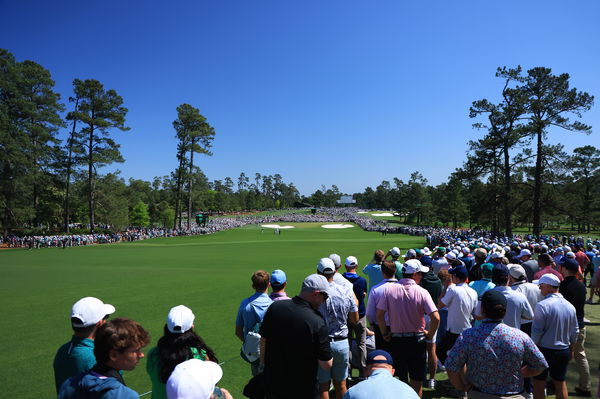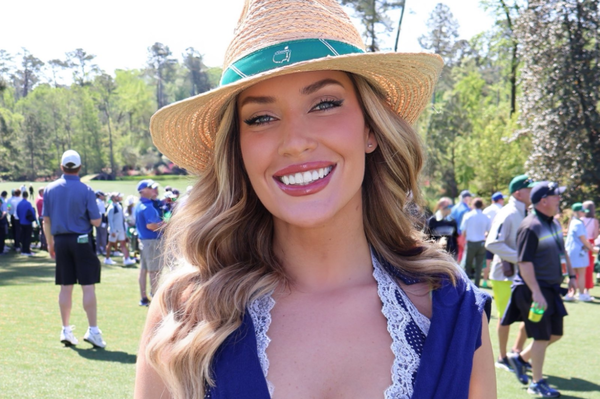Latest The Masters Tournament News


PGA Tour Insider Berates ‘Fake’ Bryson DeChambeau Over ‘Weird’ Rory McIlroy Comments at Augusta National

Rickie Fowler Finds Fault With Rory McIlroy’s Green Jacket Win After His Own Masters Dreams Turned to Dust

After Dustin Johnson, Wife Paulina Gretzky Looks on the Bright Side of Upsetting Masters Campaign: ’Augusta, Always’

Brandel Chamblee’s 4-Word Confession Reveals Rory McIlroy, Bryson DeChambeau’s Unstable Relationship

Pressures Mount on Rory McIlroy to Do More With His Career After Putting Masters Behind His Back

Paul McGinley Admits He Was ‘Really Hurt’ as Hot Take on Rory McIlroy Backfired

Bryson DeChambeau’s Expectations Questioned as Rory McIlroy Follows in Tiger Woods’s Footsteps After Masters Win

After Augusta Nightmare, Jon Rahm’s ‘Insane’ Start Sends Fans Into Frenzy: ‘Gets a Major Real Soon’

Going Against Rory McIlroy, Phil Mickelson’s Ally Asserts YouTube Golf Is the ‘Middle Ground’ Amid Ongoing Rift

Charley Hull Celebrates Rory McIlroy’s Masters Win With an Emotional Message to the World: “Should Never Forget”


More The Masters Tournament News
Paul McGinley Admits He Was ‘Really Hurt’ as Hot Take on Rory McIlroy Backfired
Paul McGinley's comment on Rory McIlroy backfired, but the former Ryder Cup captain is here to discuss what really went down.

Bryson DeChambeau’s Expectations Questioned as Rory McIlroy Follows in Tiger Woods’s Footsteps After Masters Win
Bryson DeChambeau has found himself in a pickle after his answer concerning Rory McIlroy during the Masters was not well received.

After Augusta Nightmare, Jon Rahm’s ‘Insane’ Start Sends Fans Into Frenzy: ‘Gets a Major Real Soon’
Jon Rahm is taking it brilliantly on greens despite his poor Masters finish, and fans have one hope from him.

Going Against Rory McIlroy, Phil Mickelson’s Ally Asserts YouTube Golf Is the ‘Middle Ground’ Amid Ongoing Rift
Rory McIlroy shares certain feelings for YouTube golf content creators. But the recent Masters champions has just received a response.

Charley Hull Celebrates Rory McIlroy’s Masters Win With an Emotional Message to the World: “Should Never Forget”
Charley Hull shares touching tribute to Rory McIlroy’s Masters victory, spotlighting the role of parents in shaping champions.

Rory McIlroy Gets Bold Message From Former Major Winner to Avoid Burnout After Emotional Masters Win
Rory McIlroy has three PGA Tour victories this season, and will be looking to increase the count in the days to come.

Who Is the Couple That Declined $200M Augusta National Development Offer? Everything About Them Explored
Despite Augusta National's development offers reaching millions, one family continues to hold out, choosing cherished memories over expansion

After Fresh Loss, Scottie Scheffler Opens Up on Why He Stayed Away From Rory McIlroy’s Celebratory Moment at Augusta National
Scottie Scheffler handed the green jacket to Rory McIlroy in a traditional ceremony at ANGC, while not overshadowing his special moment.

“I Laugh at Golf”: Michael Strahan Offers Hot Take Despite Tiger Woods Being His Source of Motivation
Former NFL star Michael Strahan got into golf thanks to Tiger Woods. He has now shared an observation he made about the sport.

Amanda Balionis ‘Grateful’ to Jim Nantz & More as She Exits Augusta National on an Emotional Note
How did Amanda Balionis bid farewell to Augusta National and Jim Nantz? Here's eevrything you need to know!

Jon Rahm Breaks Silence on Upsetting Augusta National Exit With 6-Word Olive Branch for His PGA Tour Rival
Despite a disappointing run at Augusta, Jon Rahm comes back from the shadows on a positive note as he congratulates a PGA Tour rival.

Bryson DeChambeau Turns Laughing Stock as Extreme Lengths He Went to for ‘Green Jacket’ Win Gets Revealed
Why is LIV Golf supertar Bryson DeChambeau turned into a laughing stock after his run at Augusta National? Here's all you need to know!

PGA Tour Champ Had the Best Reaction as Rory McIlroy Quietly Drops Massive Social Media Update After Masters Win
Rory McIlroy has finally achieved his career Grand Slam in 22025. However, his latest update reminds this PGA winner of something...

Fox’s Michael Strahan Admits Personal Reasons Behind Surprising Rory McIlroy Decision at the Masters
Why did Michael Strahan think Rory McIlroy won't win the 2025 Masters Tournament? Learn whom the Fox Sports journalist placed his bets on.

Pressure Mounts for LIV Golf PGA Tour Merger as Masters New Record Crosses Tiger Woods’s 2019 Win
Tiger Woods's 2019 Masters victory was a monumental one but was marred by weather concerns which changed timings.

2025 RBC Heritage: 5 Biggest Names Missing from PGA Tour’s Next Signature Event
Who won't take a trip to Harbour Town Golf Links this weekend? Learn about the 5 big names missing from the field for the 2025 RBC Heritage.

Rory McIlroy Flooded With Emotions As He Shares Message for Daughter Poppy With Amanda Balionis
Rory McIlroy's win at the 2025 Masters is an amwzing feat at itself, however someone's presence made it even more fulfilling.

Bryson DeChambeau’s Next Move After Masters Disappointment Leaves Golf World Perplexed: ‘Feels Weird’
Bryson DeChambeau, still reeling from a tough loss at the 2025 Masters, made a trip post the event that confused golfing fans.

‘Need To Be More Affordable’: Paige Spiranac Drops Major Complaint After Her Masters Prediction Came True
Find out about latest shocking update from Paige Spiranac hours days after her prediction about the masters.

Bryson DeChambeau Accused of Making Masters ‘All About Him’ as Bizarre 7-Word Statement From Final Round Goes Viral
Bryson DeChambeau had some words to say after a tough final round at the 2025 Masters which saw him move to T5.

Who Are Rory McIlroy’s Parents Rosaleen & Gerry McIlroy? Their Life, Career & More Explored
Who are Rosaleen and Gerry McIlroy? Learn more about the 2025 Masters champion, Rory McIlroy's parents, back in Northern Ireland.

Amanda Balionis Bids Farewell After Wishing Rory McIlroy on Making History at the Masters: ‘Bye Augusta’
Amanda Balionis reflects on Rory McIlroy’s historic 2025 Masters win, sparking emotional headlines with her heartfelt Instagram farewell.

Rory McIlroy Still Needs More to Reach Scottie Scheffler’s Level Despite Winning the Masters
Rory McIlroy wins the 2025 Masters at last, but Scottie Scheffler's ranking lead and controversial behavior steal headlines.

Vanessa Trump Joins Rory McIlroy’s Celebration as PGA Tour Pro Pours Out Emotions in 4 Words
Rory McIlroy's emotional Masters 2025 win draws praise from Vanessa Trump, LIV Golf pros, and fans worldwide.

Hours After Masters Heartbreak, Bryson DeChambeau Receives Ultimate Tribute from USGA
Despite disappointing loss at Augusta, USGA gives Bryson DeChambeau something to celebrate as they pay respect to his amazing win in 2024.

Hours After His Controversial Statement, Bryson DeChambeau’s Claim Gets Debunked Online
How did Bryson DeChambeau's statement come back to bite him? Learn how a reporter dug through the lies of the LIV Golf pro.

About The Masters Tournament
April marks a significant time on every golfer's calendar, and for one reason only: The Masters Tournament. The event is one of the four prestigious majors in the golf world, and fans eagerly await it every year. Being the most traditional event in the history of the sport, the Masters follows its own set of rules and guidelines separate from regular golf events. Explore with us the longstanding history of the Masters and its enriching traditions.
History of the Masters Tournament and its Origin
The first Masters Tournament was held in 1934, two years after it opened for play. Back then, the event was called the Augusta National Invitation Tournament. At the end of an epic battle, Horton Smith beat Craig Wood by a stroke to win the first edition of the Augusta event!
The biggest change to the major came in 1939, when the event was rebranded as the Masters Tournament. For years, Clifford Roberts and Bobby Jones debated over the name, with the former suggesting it be called the Masters because the “masters of golf” played in it. Jones, on the other hand, thought it was quite immodest until he finally caved in five years after the first tournament.

via Imago
5 Apr 1999: A ball Masters golf ball displays the length of the new rough increased to 1 3/8 of an Inch before the 1999 US Masters at the Augusta National GC in Augusta, Georgia, USA. Mandatory Credit: Stephen Munday /Allsport
One word differentiated the Augusta Major from the rest of the golf events and majors: tradition. The Masters is not just filled with history but also with religiously followed customs that make it one of the most intriguing and exciting golf events of the year.
The Augusta National Golf Club and its significance in the golfing world
Augusta was founded by Clifford Roberts and Bobby Jones in 1932. Jones teamed up with Alister MacKenzie, and together they designed the historic venue. A native of Georgia, Jones wanted to create a world-class golf course, and he picked out the 365-acre site in Augusta for his project.
Unlike many other clubs with multiple courses, Augusta has only 27 holes. The 18-hole championship course and the 9-hole par-3 course, both are famous for their own tournaments. Aside from that, the historic club is also home to famous spots like the Crows Nest and the Eisenhower Tree. The Masters course is its most notable feature, and it draws fans to it like moths to a flame!
Amen Corner is yet another special feature of the course. It refers to the area that encompasses holes 11, 12, and 13. These three holes are regarded as the most difficult at the Augusta National. It gets its name from a 1958 Sports Illustrated article by Herbert Warren Wind. He in turn drew inspiration from the song 'Shoutin’ in that Amen Corner' by Mildred Bailey and the Dorsey Brothers Orchestra.
The several traditions associated with the Masters Tournament and Augusta National
Tradition is the most commonly used word when describing the Masters, and while it may sound like a cliche, it is one filled with truth. With several customs, the event stands out as the home of golf. The most important customs and features at the event are as follows:
The Green Jacket: Every year, the champion of the major receives more than just a trophy. He takes home the coveted green jacket. The first jacket was awarded to Sam Snead in 1949 after he won the event. And since then, the tradition of the victor being awarded with the green jacket has continued.
The jackets represent the spirit of Augusta, and the champions are made to wear them so that they stand apart from the crowd. Roberts drew this idea from when the Masters officials began wearing green to distinguish them as “reliable sources of information” in a crowd.

USA Today via Reuters
PGA, Golf Herren Masters Tournament ”“ Final Round, Nov 15, 2020 Augusta, Georgia, USA 2019 Masters champion Tiger Woods presents Dustin Johnson with the green jacket after winning The Masters golf tournament at Augusta National GC. Mandatory Credit: Michael Madrid-USA TODAY Sports, 15.11.2020 13:17:49, 15203343, Tiger Woods, Dustin Johnson, PGA, The Masters, Final Round PUBLICATIONxINxGERxSUIxAUTxONLY Copyright: xMichaelxMadridx 15203343
The Champions Dinner: One of the most exciting traditions at the Masters is the champions dinner. Every year on the eve of the beginning of the tournament, all the past champions gather for a dinner that is organized by the defending champion. It is one of the most coveted customs of the event, and it first began in 1952, and has been followed since.
The Par 3 Contest: Preceding the first round of the Masters, on Wednesday, the par 3 contest is held. It first began in 1960 as a way to keep the fans more engaged, but soon it evolved into one of the most enthralling customs at Augusta.
The contest is played over nine holes at par 27, with the player with the lowest score being declared the winner at the end of the match. The participating pros and past champions take the par-3 tournament field and are joined by their families, who are allowed to caddie for them. And even play holes at times!
The Eisenhower Tree: Located just off the 17th fairway, the Eisenhower Tree is Augusta's most famous loblolly pine. It was named after the American President, Dwight D. Eisenhower, who once hit into it while playing and lobbied to have it removed! Unfortunately, in 2014, after sustaining heavy damage during an ice storm, the tree was removed.
The Drive, Chip, and Putt: In 2013, the USGA, the PGA of America, and the Masters put together the first Drive, Chip, and Putt ”“ a free nationwide junior golf development competition, to grow the game by focusing on the sport’s three fundamental skills. From ages 7 to 15, boys and girls can participate in the tournament, and those who qualify through the rounds make it to the National Finals held at Augusta the Sunday before the Masters.
Skipping balls: During the practice rounds every year, at the 16th hole, a.k.a. 'Redbud',fans cheer for golfers and urge them on to try and skip their ball on the water of the pond at the hole and get it to land on the greens.
Honorary Starters: The Masters is all about celebrating history, and this tradition that began in 1963 does just that. On Thursday, the older golfers who no longer compete in the event start the tournament by striking golf balls early in the morning on Thursday. Jock Hutchison and Fred McLeod were the first honorary founders, and ever since the custom has been followed.
The Crows Nest: One of Augusta's most iconic historical places on the property is the Crow's Nest. It is located on the second floor of the clubhouse at Augusta National. From golf books to art works on the wall, the five-person accommodation provides a unique experience for the amateurs staying there.
The Champions Locker Room: 1978 saw the introduction of the Champions Locker Room. As the name suggests, it is the locker room for the past winner of the event. Every winner has a locker in the room, and it's not just for show either. Every year, the past champions competing at Augusta use that locker room!
The most successful golfers in Masters history and their accomplishments
The golf legend, Jack Nicklaus, is both the most decorated major winner as well as the most accomplished Masters winner in the history of the event. With six wins to his name, the 'Golden Bear' made history at the course in 1986, where he won for the last time. At the age of 46 years and 82 days, he became the oldest golfer to take home the trophy.

No golfer has ever won three Green Jackets in a row, but Nicklaus, Tiger Woods, and Sir Nick Faldo have all won back-to-back Masters, with Woods's being the most recent in 2001 and 2002. Woods's first Masters win in 1997 was also history, for he then became the youngest ever professional to win the Green Jacket, at 21 years and 104 days.
The economic impact of the Masters Tournament on Augusta, Georgia, and the surrounding area
The Masters is undoubtedly Augusta National's highlight of the year. For that one week in April, everything in Augusta is booming. In 2022, Forbes calculated exactly how much the event made for the course, and it stood at a whopping $141 million.
This includes the revenue from merchandise and TV rights. And despite giving its domestic broadcasting rights for free and pricing badges ($75 for practice rounds, $115 for single-day competitive round passes, and $375 for the entire four-day event) and concessions (capped at $25) at a very affordable rate, the event seems to make quite a bit for itself.
But the Masters doesn't just make things good for Augusta National; it also helps out the entire city of Augusta. Seeing as to how big the event is, during April every year, both the tourism and the economy of the city witness a rapid increase. Local business and even employment boom during that time of the year.

via Reuters
Golf ”“ The Masters ”“ Augusta National Golf Club ”“ Augusta, Georgia, U.S. ”“ April 10, 2022 Scottie Scheffler of the U.S. celebrates on the 18th green after winning The Masters REUTERS/Mike Segar
The hospitality sector flourishes, with hotels and houses for rent being fully booked by April. Dr. Marsha Loda, an associate marketing professor at Augusta University's Hull College of Business, calculated the monetary impact on the city in 2021 to be close to $120 million, with Richmond County collecting nearly $1.4 million in hotel-motel tax during the month.
It’s clear that the Masters is more than just a major championship in golf. It is a sensation.





